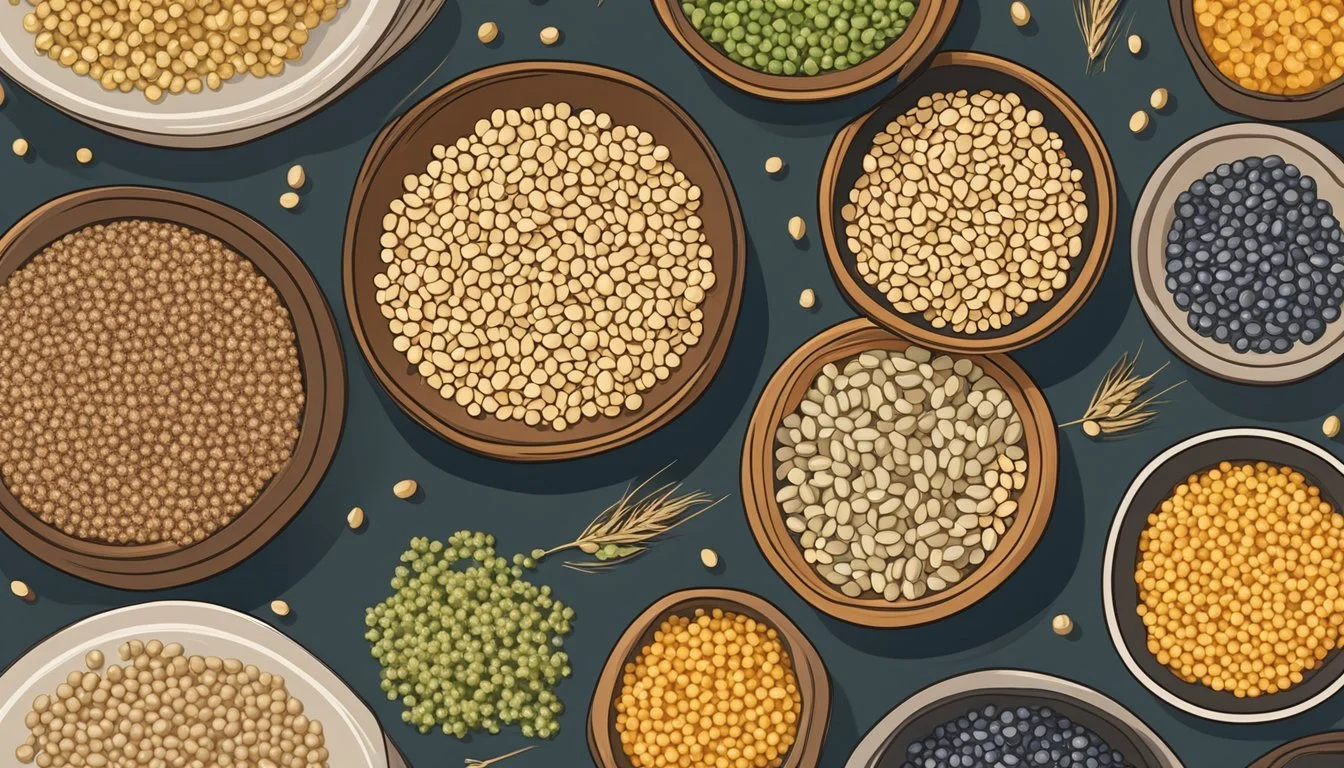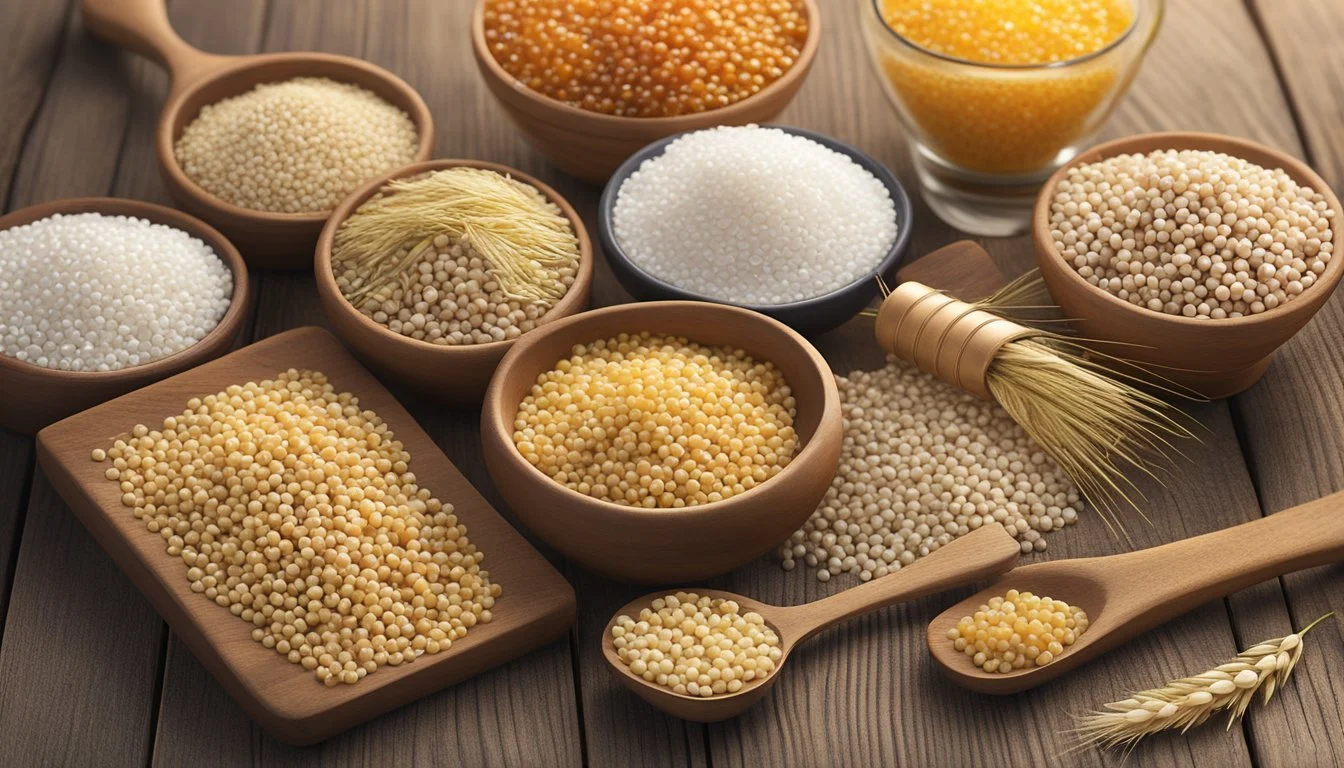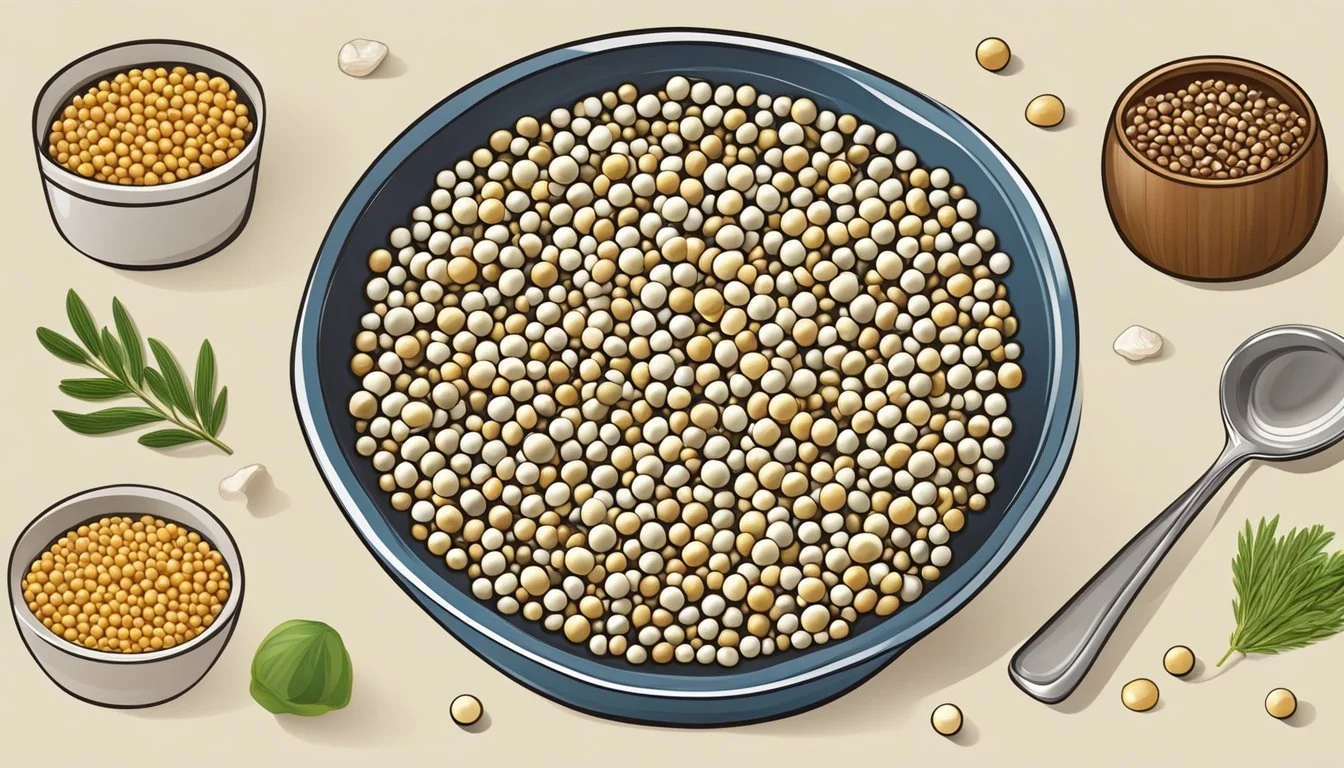Barley Pearls Substitutes
Top Alternatives for Your Recipes
For those looking to replace pearl barley in their recipes, a variety of nutritious and gluten-free alternatives are available. Quinoa is an excellent substitute with a broader amino acid profile, making it a versatile option for many dishes. Its adaptability in recipes ensures it can be used in equal proportions to pearl barley, providing both texture and nutritional benefits.
Brown rice offers another fantastic alternative due to its chewy texture and slightly nutty taste. Rich in fiber, minerals, and vitamins, brown rice not only mimics the texture of pearl barley but also boosts the nutritional value of your dishes. Suitable for a range of recipes, it can be added to soups, salads, and more.
Less common, yet equally valuable, alternatives include buckwheat and teff. Buckwheat, with fewer calories and carbohydrates, provides a lighter option, while teff, a gluten-free whole grain, can significantly enhance the nutrient profile of your meals. Both substitutes introduce unique flavors and benefits, expanding your culinary possibilities.
Understanding Barley Pearls
Barley pearls, commonly known as pearl barley, offer numerous nutritional benefits, diverse cooking characteristics, and an essential role in various recipes.
Nutritional Profile
Pearl barley is a nutritious whole grain that retains several essential nutrients despite the removal of its bran layer. It is high in fiber, which aids in digestion and promotes a healthy gut. A serving of pearl barley contains 6 grams of protein, making it a valuable plant-based protein source.
In addition to fiber and protein, pearl barley is rich in vitamins and minerals such as vitamin B, iron, magnesium, and selenium. These nutrients contribute to overall health by supporting metabolic functions and providing antioxidants. While the bran layer removal reduces some fiber content, the remaining nutritional load ensures significant dietary benefits.
Cooking Characteristics
Pearl barley is celebrated for its chewy texture and nutty flavor, making it versatile across various culinary applications. Upon cooking, it absorbs flavors well, enhancing the overall taste of the dish.
To cook pearl barley, rinse it thoroughly and boil it with water in a ratio of 1:3. Typically, it takes 45 to 50 minutes to cook, resulting in a tender consistency with a slight bite. This cooking process makes pearl barley suited for soups, stews, and salads, providing a hearty component to meals with its distinctive texture.
Role in Recipes
In recipes, pearl barley acts both as a filler and a main ingredient, adding substance and nutritional value. Due to its chewy texture and ability to absorb liquids, it is frequently used in soups and stews. This quality ensures that dishes become more satisfying and rounded in flavor.
Pearl barley's nutty flavor complements various ingredients, such as vegetables and meats. It can be used in salads to add a unique texture or as a rice substitute in risottos for a twist on traditional recipes. Its adaptability makes it an excellent staple for diverse culinary creations, ensuring that meals are both delicious and nutritious.
Health Benefits of Barley
Barley is packed with fiber, which plays a crucial role in supporting digestive health. The high fiber content helps regulate bowel movements and can reduce the risk of digestive disorders.
This grain is also rich in nutrients such as vitamins and minerals. Notable components include B vitamins like vitamin B6, which are essential for energy production and brain function.
Minerals found in barley include magnesium, iron, selenium, phosphorus, and manganese. These minerals contribute to various bodily functions:
Magnesium aids in over 300 enzymatic reactions.
Iron is crucial for oxygen transport in the blood.
Selenium and manganese act as antioxidants, protecting cells from damage.
Phosphorus supports bone health.
Barley contains proteins, which are important for muscle repair and growth. It also provides copper and calcium, further contributing to bone health.
This nutritious grain also includes antioxidants that help in reducing inflammation and protecting against free radical damage.
Adding barley to the diet can provide a wide array of micronutrients, enhancing overall health and well-being. The combination of fiber, proteins, vitamins, and minerals makes barley a valuable addition to a balanced diet.
Common Barley Substitutes and Their Properties
This section explores various alternatives to barley, focusing on their nutritional profiles, flavors, and best uses in the kitchen. These substitutes vary in dietary compatibility and culinary application, ensuring options for different dietary needs and recipe preferences.
Quinoa as a Substitute
Quinoa is a nutritious, gluten-free whole grain that offers a high protein content and a complete amino acid profile. It has a nutty flavor and a slightly chewy texture, making it a versatile option for dishes traditionally using barley.
Quinoa is rich in fiber, vitamins, and minerals. It cooks faster than barley, typically requiring about 15 minutes to prepare. Use it in soups, salads, and side dishes. Because it's gluten-free, quinoa is suitable for those with gluten sensitivities or celiac disease.
Farro and Its Nutty Appeal
Farro is an ancient grain known for its slightly nutty flavor and chewy texture similar to barley. It is not gluten-free but offers a rich source of fiber, protein, and nutrients like magnesium and iron.
Farro requires soaking to reduce cooking time, which is roughly 25-40 minutes after soaking. It's ideal for hearty soups, stews, and salads. Farro's robust texture holds up well in dishes that require prolonged cooking.
Brown Rice and Its Versatility
Brown rice is an easily accessible alternative with a mild, nutty flavor and chewy texture. It is a staple in many diets globally and is valued for being a whole grain with high fiber and essential nutrients.
Cooking brown rice takes approximately 45-50 minutes. It is ideal for pilafs, stir-fries, and as a base for grain bowls. Brown rice is gluten-free, serving as a safe option for those who need to avoid gluten.
Bulgur Wheat: A Middle Eastern Staple
Bulgur wheat, a common ingredient in Middle Eastern cuisine, is made from cracked whole wheat kernels that are parboiled, dried, and crushed. It cooks swiftly, usually within 10-12 minutes.
Bulgur has a nutty flavor and slightly chewy texture. It's a good source of fiber and protein but is not gluten-free. Use bulgur in tabbouleh, kibbeh, and as a side dish. Its quick preparation makes it a convenient barley substitute for busy weeknight meals.
Specialty and Gluten-Free Alternatives
When looking for substitutes for barley pearls, consider several specialty and gluten-free options that provide a nutritious and suitable replacement. These alternatives cater to dietary needs and offer unique textures and flavors.
Sorghum and Millet
Sorghum is a versatile, gluten-free grain known for its hearty texture and mild, nutty taste. Rich in essential nutrients such as fiber, protein, and antioxidants, sorghum can be used in salads, soups, and side dishes. It can also be popped like popcorn for a nutritious snack.
Millet is another gluten-free grain that serves as an excellent pearl barley substitute. With its mild sweetness and fluffy texture, millet works well in porridges, pilafs, and baked goods. Millet is high in fiber and essential minerals, making it a nutritious alternative to barley.
Amaranth and Teff
Amaranth is not technically a grain but offers similar properties to barley. It’s rich in protein, fiber, and essential minerals. Due to its slightly sticky texture when cooked, amaranth is ideal for soups, stews, and porridges. Its nutty flavor enhances many dishes, providing a gluten-free and nutritious option.
Teff is an incredibly small grain with a gritty texture. Rich in protein and high in iron, calcium, and fiber, teff is an excellent gluten-free substitute for pearl barley. Its mild flavor works well in soups, stews, and as a side dish. Teff's unique properties make it a standout among gluten-free grains.
Legumes as Hearty Replacements
Lentils and other legumes can serve as hearty substitutes for barley pearls. They are gluten-free and loaded with protein, fiber, and various essential nutrients. Lentils come in various colors and textures, making them versatile for soups, stews, and salads.
Other legumes, such as chickpeas and black beans, also provide excellent nutritional profiles and are adaptable in many recipes. Their hearty texture makes them suitable for replacing barley in dishes requiring a robust and filling component.
Texture and Flavor Considerations
When choosing substitutes for pearl barley, it’s essential to match its chewy texture and mild, nutty flavor. Some grains share these characteristics and can serve as suitable replacements.
Matching Barley's Texture
Farro has a chewy texture similar to barley. This ancient grain offers a satisfying bite, making it a great substitute in dishes where the chewiness of barley is desired.
Quinoa provides a slightly chewy texture. While it’s not exactly the same as barley, it works well in soups and salads where a firmer texture is needed.
Sorghum also offers a chewy consistency. It can be cooked in a way that retains its bite, making it suitable for stews and other hearty dishes.
Brown Rice has a firm texture but isn’t as chewy as barley. It's less processed, retaining more nutrients, which can be beneficial in healthier recipes.
Complementing Barley's Flavor
Farro has a nutty flavor that closely resembles barley’s mild taste. This makes it an excellent choice when the dish benefits from a more pronounced, earthy flavor.
Quinoa also has a subtle nutty flavor. Its versatility makes it a good match for many dishes that originally call for barley, especially in salads and side dishes.
Sorghum features a mild, slightly nutty taste. This grain absorbs flavors well, making it adaptable to various recipes.
Brown Rice offers a relatively neutral flavor. While not as nutty, it can absorb spices and sauces effectively, making it a flexible alternative in dishes focusing on other flavors.
Utilizing Substitutes in Specific Dishes
Substituting pearl barley in recipes can still achieve delicious results. Key considerations include the texture, cooking time, and dietary preferences that each substitute brings to a dish.
Substitutes in Soups and Stews
For soups and stews, brown rice and quinoa are excellent substitutes for pearl barley. Brown rice offers a slightly chewy texture and absorbs flavors well, though it requires a longer cooking time. Quinoa cooks faster and provides a nutty taste, making it ideal for quick meals.
Amaranth and sorghum are also worth considering. Amaranth has a porridge-like consistency when cooked, which can thicken soups effectively. Sorghum stays firm and chewy, giving texture similar to pearl barley. Adding these grains can enhance the nutritional profile, providing proteins and essential amino acids.
Grain Salads and Side Dishes
When preparing grain salads and side dishes, farro and couscous are popular options. Farro has a nutty flavor and chewy texture that works well in salads such as tabbouleh, offering a hearty base. Couscous, being lighter and fluffier, suits dishes where a less dense texture is desired.
For gluten-free choices, buckwheat and wild rice are excellent. Buckwheat has a robust flavor and firm texture, making it perfect for cold salads. Wild rice provides a unique, slightly crunchy texture and earthy flavor, suitable for various side dishes. These alternatives maintain the integrity of the dish while meeting dietary needs.
Risotto and Pilafs
In risotto and pilafs, it's crucial to pick substitutes that can mimic the creamy texture achieved with pearl barley. Arborio rice is a fantastic choice for risotto due to its high starch content that creates a creamy consistency when cooked.
For pilafs, bulgur wheat and millet can be used. Bulgur wheat cooks quickly and has a light, nutty flavor, making it a good match for various pilaf recipes. Millet has a slightly sweet taste and fluffs up nicely, providing a different yet pleasant texture.
These substitutes ensure that your dishes remain satisfying and aligned with individual dietary preferences while replicating the key characteristics of pearl barley.
Practical Tips for Cooking Substitutes
When using substitutes for pearl barley, it is essential to adjust cooking techniques to achieve the desired texture and consistency. Key points include adapting cooking times, proper soaking procedures, and making adjustments for texture differences.
Adjusting Cooking Time
Quinoa: Cooks much faster than barley. Use a 2:1 water-to-quinoa ratio and simmer for 15-20 minutes until tender.
Brown Rice: Requires more time. Use 2 1/2 cups of water for every cup of rice, cooking for 45-50 minutes.
Buckwheat: Similar to quinoa in cooking time. Simmer with a 2:1 ratio of water to buckwheat for 15-20 minutes.
Soaking and Preparation
Brown Rice: Rinse thoroughly to remove excess starch. This step ensures a less sticky final texture.
Farro: Benefits from being soaked overnight. This reduces its cooking time significantly, making it more convenient for quicker meal prep.
Teff: This seed does not require soaking but should be rinsed to clean it before cooking.
Texture and Consistency Adjustments
Quinoa: Has a fluffy, slightly crunchy texture. To achieve a more barley-like consistency, simmer longer and use a bit more water.
Farro: Naturally chewy and nutty. Extend the cooking time slightly for a softer texture akin to barley.
Teff: Yields a creamy, porridge-like consistency. Adjust water amounts based on the desired thickness, using less water for firmer results.
Considerations for Dietary Restrictions
When choosing substitutes for pearl barley, dietary restrictions play an essential role in determining the best alternative.
Because pearl barley contains gluten, those with celiac disease or gluten intolerance need suitable options. Gluten-free grains like quinoa, buckwheat, and teff are excellent choices.
Quinoa is a nutrient-rich grain high in dietary fiber and protein, making it ideal for diverse dietary needs. Buckwheat, also gluten-free, offers lower calories and carbohydrates compared to pearl barley.
Dietary fiber is an important nutrient that should be considered. Brown rice, for instance, is a fiber-rich substitute that also provides essential minerals and vitamins.
For individuals with allergies, it's important to check for potential allergens in alternative grains. Non-gluten grains such as millet and sorghum can be considered, as they are typically hypoallergenic.
A summary of gluten-free substitutes is as follows:
Substitute Gluten-Free Dietary Fiber Notes Quinoa Yes High Rich in protein and minerals Buckwheat Yes Moderate Lower in calories and carbs Teff Yes Moderate Nutrient-dense whole grain Brown Rice Yes High Chewy texture, versatile in recipes
Taking these considerations into account ensures that those with dietary restrictions can still enjoy meals without compromising on nutrition or taste.
Finding Substitutes in Your Kitchen
Finding suitable substitutes for pearl barley in your kitchen can greatly enhance your home cooking by adding variety and accommodating dietary needs. There are various common pantry staples and specialty items from health food stores that can serve as excellent replacements.
Pantry Staples
Certain pantry staples are great substitutes for pearl barley due to their similar textures and cooking methods. Quinoa stands out because it offers a complete amino acid profile and has a nutty flavor. It cooks faster than barley and can be used in soups, stews, and salads in equal proportions.
Another option is brown rice. It is known for being a staple in many diets around the world. When using brown rice, remember to rinse it thoroughly to remove excess starch and cook it for 45-50 minutes, using about 2 1/2 cups of water for every cup of rice. Brown rice's chewy texture makes it a versatile ingredient for various recipes.
For those who enjoy a coarser texture, bulgur wheat is an excellent choice. It requires minimal cooking time and is perfect for salads and pilafs. Though it contains gluten, bulgur is nutritious and adds a delightful bite to dishes.
Health Food Store Finds
Health food stores often stock a variety of grains that make suitable substitutes for pearl barley. Amaranth is one such grain. High in protein and fiber, it is a nutritious option that's ideal for stews and soups. Amaranth's slightly sweet and nutty flavor enhances the taste profile of many dishes.
Sorghum is another fantastic substitute available at health food stores. It is a gluten-free grain known for its mild, nutty flavor and chewy texture that mimics pearl barley. Sorghum can be cooked like rice and incorporated into an array of recipes, including soups and stews.
Farro is a traditional grain that's gaining popularity. Soaking farro overnight reduces its cooking time significantly, making it a quicker alternative to pearl barley. Its hearty texture makes it suitable for salads, soups, and risottos.
By exploring these pantry and health food store alternatives, you can diversify your recipes and accommodate different dietary needs without compromising on taste or texture.







